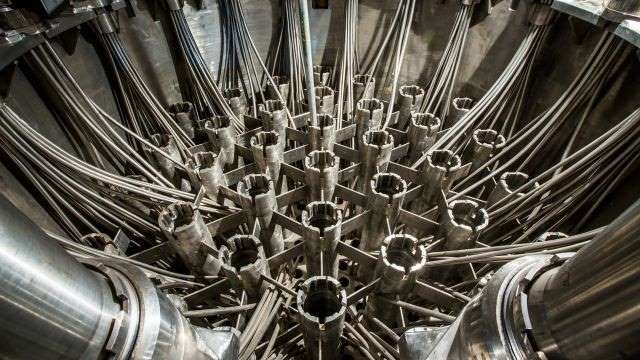March 22, 2016
Despite opposition and safety concerns, nuclear power remains a big part of the world’s energy mix—providing about 10% of world’s electricity. And since nuclear reactors typically last 40 years, there are still hundreds of decades-old reactors around the world that must be maintained.

Ready to take another battering.
March 22, 2016
Despite opposition and safety concerns, nuclear power remains a big part of the world’s energy mix—providing about 10% of world’s electricity. And since nuclear reactors typically last 40 years, there are still hundreds of decades-old reactors around the world that must be maintained.

Ready to take another battering.
Most of those reactors are made up primarily of some form of stainless steel. But steel is showing its limitations—primarily that it can weaken or become defective over time, and in extreme cases break apart. This is an even bigger concern in newer reactors that run at higher temperatures and have more fast-moving neutrons. So scientists have been on the hunt for metal alloys that are stronger and can last longer, and researchers in Finland and the US may have found a new category of such alloys. In a study to be published in Physics Review Letters, they report that high-entropy alloys could do the job better than steel.
A nuclear reactor sees the bombardment of neutrons onto radioactive fuel. As heavy atoms split apart, they produce more neutrons and vast amounts of heat (which powers turbines and thus produces electricity). While a vast majority of unnecessary neutrons are stopped by heavy water that fills the reactor, some make their way to the metal exterior that holds the reactor together. When they hit that metal, they can dislodge the atoms that form the metal’s crystalline structure. Such dislodging causes defects, which can cause the reactor to break apart if they’re not fixed.
The scientists tested two high-entropy alloys—a new class of metals made up of several elements in equal percentages—against steel made of iron and chromium. They bombarded each metal plate with nickel and gold ions, which simulates what might happen to a metal in a nuclear reactor. In each case, the high-entropy alloy had two or three times fewer defects than steel.
These are promising results, according to University of Finland researcher Kai Nordlund. In a high-entropy alloy, each type of atom is nearly equally exposed to incoming particles. Other alloys require a base metal, such as iron in steel, which means that one type of atom is more exposed to incoming particles than others. This difference means that in high-entropy alloys the chances of dislodging slightly differently sized atoms is about the same, and this gives them a better ability to deal with defects.
“High-entropy metals have been around for at least 15 years,” Nordlund told Quartz, “but we’ve only recently become good at making them at a high enough quality to test them.”
Next, Nordlund will need to test the alloys against the steel used by actual nuclear reactors. If they perform better, there are many other metal alloys that he and his team could try. For now large-scale manufacturing of high-entropy alloys is prohibitively expensive, but the hope is that at some point the new metals will be cheap enough to use in nuclear reactors.
Courtesy: Quartz
















































































































